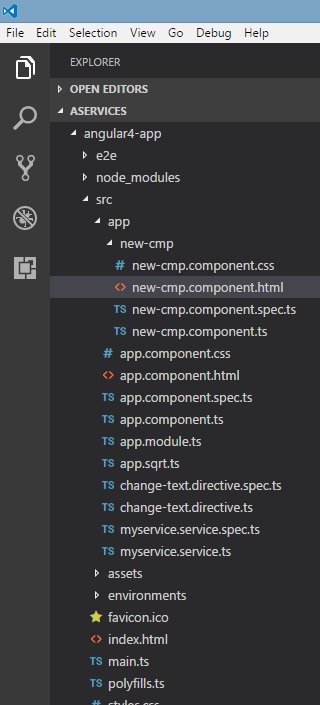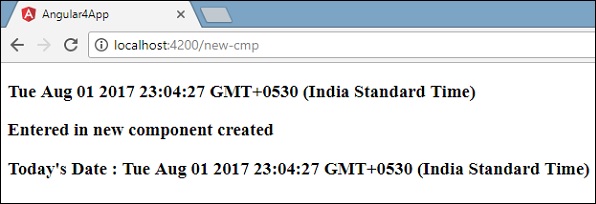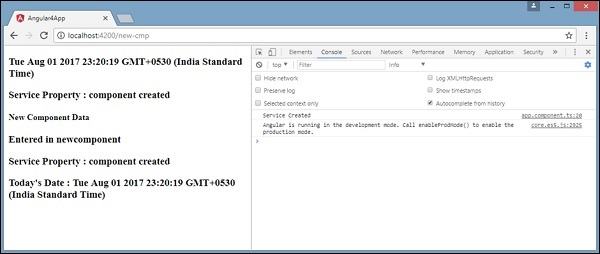
- Angular 4 教程
- Angular 4 - 首頁
- Angular 4 – 概述
- Angular 4 – 環境搭建
- Angular 4 – 專案搭建
- Angular 4 – 元件
- Angular 4 – 模組
- Angular 4 – 資料繫結
- Angular 4 – 事件繫結
- Angular 4 – 模板
- Angular 4 – 指令
- Angular 4 – 管道
- Angular 4 – 路由
- Angular 4 - 服務
- Angular 4 - Http 服務
- Angular 4 - 表單
- Angular 4 - 動畫
- Angular 4 - 材料設計
- Angular 4 - CLI
- Angular 4 - 例子
- Angular 4 有用資源
- Angular 4 - 快速指南
- Angular 4 - 有用資源
- Angular 4 - 討論
Angular 4 - 服務
本章將討論 Angular 4 中的服務。
我們可能會遇到這種情況:我們需要一些程式碼在頁面的任何地方使用。這可能是需要跨元件共享的資料連線等。服務幫助我們實現這一點。透過服務,我們可以訪問整個專案中其他元件的 方法和屬性。
要建立服務,我們需要使用命令列。相應的命令是:
C:\projectA4\Angular 4-app>ng g service myservice installing service create src\app\myservice.service.spec.ts create src\app\myservice.service.ts WARNING Service is generated but not provided, it must be provided to be used C:\projectA4\Angular 4-app>
檔案如下建立在 app 資料夾中:

以下是底部建立的檔案 - **myservice.service.specs.ts** 和 **myservice.service.ts**。
myservice.service.ts
import { Injectable } from '@angular/core';
@Injectable()
export class MyserviceService {
constructor() { }
}
這裡,Injectable 模組從 **@angular/core** 匯入。它包含 **@Injectable** 方法和一個名為 **MyserviceService** 的類。我們將在這個類中建立我們的服務函式。
在建立新服務之前,我們需要在主要的父級 **app.module.ts** 中包含已建立的服務。
import { BrowserModule } from '@angular/platform-browser';
import { NgModule } from '@angular/core';
import { RouterModule} from '@angular/router';
import { AppComponent } from './app.component';
import { MyserviceService } from './myservice.service';
import { NewCmpComponent } from './new-cmp/new-cmp.component';
import { ChangeTextDirective } from './change-text.directive';
import { SqrtPipe } from './app.sqrt';
@NgModule({
declarations: [
SqrtPipe,
AppComponent,
NewCmpComponent,
ChangeTextDirective
],
imports: [
BrowserModule,
RouterModule.forRoot([
{
path: 'new-cmp',
component: NewCmpComponent
}
])
],
providers: [MyserviceService],
bootstrap: [AppComponent]
})
export class AppModule { }
我們已經匯入了帶有類名的服務,並在 providers 中使用了相同的類。現在讓我們切換回服務類並建立一個服務函式。
在服務類中,我們將建立一個函式來顯示今天的日期。我們可以在主要的父元件 **app.component.ts** 和我們在上一章中建立的新元件 **new-cmp.component.ts** 中使用相同的函式。
現在讓我們看看該函式在服務中的外觀以及如何在元件中使用它。
import { Injectable } from '@angular/core';
@Injectable()
export class MyserviceService {
constructor() { }
showTodayDate() {
let ndate = new Date();
return ndate;
}
}
在上一個服務檔案中,我們建立了一個函式 **showTodayDate**。現在我們將返回新建立的 Date()。讓我們看看如何在元件類中訪問此函式。
app.component.ts
import { Component } from '@angular/core';
import { MyserviceService } from './myservice.service';
@Component({
selector: 'app-root',
templateUrl: './app.component.html',
styleUrls: ['./app.component.css']
})
export class AppComponent {
title = 'Angular 4 Project!';
todaydate;
constructor(private myservice: MyserviceService) {}
ngOnInit() {
this.todaydate = this.myservice.showTodayDate();
}
}
**ngOnInit** 函式在建立的任何元件中都會預設呼叫。日期如上所示從服務中獲取。要獲取服務的更多詳細資訊,我們需要首先在元件 **ts** 檔案中包含該服務。
我們將在 **.html** 檔案中顯示日期,如下所示:
{{todaydate}}
<app-new-cmp></app-new-cmp>
// data to be displayed to user from the new component class.
現在讓我們看看如何在建立的新元件中使用服務。
import { Component, OnInit } from '@angular/core';
import { MyserviceService } from './../myservice.service';
@Component({
selector: 'app-new-cmp',
templateUrl: './new-cmp.component.html',
styleUrls: ['./new-cmp.component.css']
})
export class NewCmpComponent implements OnInit {
todaydate;
newcomponent = "Entered in new component created";
constructor(private myservice: MyserviceService) {}
ngOnInit() {
this.todaydate = this.myservice.showTodayDate();
}
}
在我們建立的新元件中,我們需要首先匯入我們想要的服務並訪問其方法和屬性。請參見突出顯示的程式碼。todaydate 在元件 html 中顯示如下:
<p>
{{newcomponent}}
</p>
<p>
Today's Date : {{todaydate}}
</p>
新元件的選擇器用於 **app.component.html** 檔案中。來自上面 html 檔案的內容將在瀏覽器中顯示如下:

如果更改任何元件中服務的屬性,則其他元件中的屬性也會更改。現在讓我們看看這是如何工作的。
我們將在服務中定義一個變數,並在父元件和新元件中使用它。我們將再次更改父元件中的屬性,並將檢視在新元件中是否也更改了。
在 **myservice.service.ts** 中,我們建立了一個屬性並在其他父元件和新元件中使用了它。
import { Injectable } from '@angular/core';
@Injectable()
export class MyserviceService {
serviceproperty = "Service Created";
constructor() { }
showTodayDate() {
let ndate = new Date();
return ndate;
}
}
現在讓我們在其他元件中使用 **serviceproperty** 變數。在 **app.component.ts** 中,我們訪問變數的方式如下:
import { Component } from '@angular/core';
import { MyserviceService } from './myservice.service';
@Component({
selector: 'app-root',
templateUrl: './app.component.html',
styleUrls: ['./app.component.css']
})
export class AppComponent {
title = 'Angular 4 Project!';
todaydate;
componentproperty;
constructor(private myservice: MyserviceService) {}
ngOnInit() {
this.todaydate = this.myservice.showTodayDate();
console.log(this.myservice.serviceproperty);
this.myservice.serviceproperty = "component created"; // value is changed.
this.componentproperty = this.myservice.serviceproperty;
}
}
我們現在將獲取變數並處理 console.log。在下一行,我們將變數的值更改為“**元件已建立**”。我們將在 **new-cmp.component.ts** 中執行相同的操作。
import { Component, OnInit } from '@angular/core';
import { MyserviceService } from './../myservice.service';
@Component({
selector: 'app-new-cmp',
templateUrl: './new-cmp.component.html',
styleUrls: ['./new-cmp.component.css']
})
export class NewCmpComponent implements OnInit {
todaydate;
newcomponentproperty;
newcomponent = "Entered in newcomponent";
constructor(private myservice: MyserviceService) {}
ngOnInit() {
this.todaydate = this.myservice.showTodayDate();
this.newcomponentproperty = this.myservice.serviceproperty;
}
}
在上面的元件中,我們什麼也沒有更改,而是直接將屬性分配給元件屬性。
現在,當您在瀏覽器中執行它時,服務屬性將被更改,因為它的值在 **app.component.ts** 中已更改,並且將在 **new-cmp.component.ts** 中顯示相同的值。
更改前也請檢查控制檯中的值。
